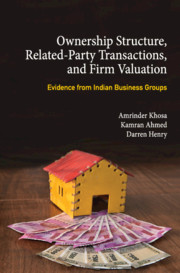 Ownership Structure, Related Party Transactions, and Firm Valuation
Ownership Structure, Related Party Transactions, and Firm Valuation Book contents
- Frontmatter
- Contents
- List of Tables
- 1 Introduction
- 2 The Evolution of Business Groups, Institutional Framework in India, and Related-Party Transactions
- 3 Theory and Literature Review
- 4 Hypotheses Development
- 5 Research Methods
- 6 Descriptive Statistics
- 7 Empirical Results
- 8 Additional Tests
- 9 Implications of the Study and Conclusion
- Appendix 1 List of Sample Firms
- Appendix 2 List of Business Groups
- References
- Index
7 - Empirical Results
Published online by Cambridge University Press: 26 April 2019
- Frontmatter
- Contents
- List of Tables
- 1 Introduction
- 2 The Evolution of Business Groups, Institutional Framework in India, and Related-Party Transactions
- 3 Theory and Literature Review
- 4 Hypotheses Development
- 5 Research Methods
- 6 Descriptive Statistics
- 7 Empirical Results
- 8 Additional Tests
- 9 Implications of the Study and Conclusion
- Appendix 1 List of Sample Firms
- Appendix 2 List of Business Groups
- References
- Index
Summary
This chapter presents the results of the main analysis and hypotheses testing of the study, focusing on the value relevance of ownership structure and RPTs. Multivariate analysis is presented using OLS regressions. In the first section, the effect of direct and indirect ownership of controlling families on firm value is examined. The second part of this chapter presents results on the value relevance of RPTs and the impact of indirect ownership of controlling families on RPT valuation. First, the results of transactions with group member firms are presented. Second, the RPTs involving subsidiary and holding firms are examined. This is then followed by a discussion on the distinct market valuation for these RPTs.
Ownership structure and firm value
This section provides evidence on the influence of ownership rights on firm valuation. First, the results of OLS regression estimation are presented to determine the association between direct and indirect ownership rights and the MVE. This is followed by quadratic equation analysis to examine the non-linear relationship between ownership rights and MVE. Finally, the results on the relationship between minority shareholder ownership and MVE are provided.
Family ownership and f irm value
Table 7.1 presents the results of the value relevance model for ownership rights of controlling families. This model shows a significant positive coefficient for direct and indirect ownership rights of controlling families. However, the direct ownership of controlling families variable has a higher coefficient than the indirect ownership rights variable (direct 0.925; indirect 0.761). This supports the view that cross-holding (indirect ownership) has a less positive influence than direct ownership. However, this evidence might not prove sufficient to draw any conclusions. Therefore, we examine this issue further in the next section with more analysis.
The effect of domestic institutional investors on the firm value varies across different categories of investors. Ownership of mutual funds is positively associated with firm value, whereas financial institutions and government ownership is negatively valued. Prior studies such as Douma et al. (2006) and Sarkar and Sarkar (2000) provide similar results that domestic financial institutional ownership negatively affects firm value. Ramaswamy et al. (2002) argue that financial institutions in developing economies, which are predominantly government owned, espouse social welfare objectives. Therefore, financial institutions are less likely to be vigilant in their monitoring role, which will be reflected in lower market value measured in financial term.
- Type
- Chapter
- Information
- Ownership Structure, Related Party Transactions, and Firm ValuationEvidence from Indian Business Groups, pp. 112 - 129Publisher: Cambridge University PressPrint publication year: 2019
